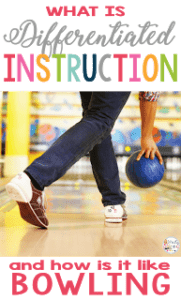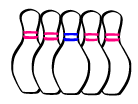
If you teach in a classroom today than you are familiar with the term Differentiation. And if you are like me you may have a love hate relationship with this term.
Classrooms today are complex and trying to teach to the individual instead of the group feels overwhelming. One of my of the realities of my teaching job depends on my ability to differentiated instruction.

For the month of March, I invite you to join me as I dig deeper into
- What differentiation means in the classroom
- How to do it effectively without pulling your hair out.
A bit about why
As a classroom teacher of a combined grade class with often a high proportion of students with special education needs I am no stranger to a difficult class that comes to me at all different levels. Being that it is just me in the classroom with all of my students I have learned some tips and tricks to differentiate and hone my skills in order to survive.
As a result I have become one of those crazy teachers that actually enjoys teaching splits and this is primarily because it helps to support differentiated instruction.

Differentiation and bowling?
In my research into digging deeper into differentiation, I discovered a lot of connections between teaching and bowling. I think when most people go out for a fun night of bowling they try to throw the ball right down the middle.
“Try to roll the ball down the middle and get most of the students.”
But if we bowl or teach like this then we are missing the point of differentiation. Shelley Moore has looked into this further and when talking to pro bowlers she found that they don’t aim for the middle but aim for the pins that are hardest to knockdown. She has helped me to instead look at this comparison to bowling differently.
“Teaching is like bowling because in order to knock down all the pins you need try to knock down the hardest to hit pins first.” – Adapted from Shelley Moore
So what does it mean?
Differentiation is good for all but necessary for some and this is why when planning you should plan with the hardest to reach students first and understand that some of the things you might do to teach these hard-to-reach students will work for all kids even the ones in the middle.
Ways to differentiate
According to Carol Ann Tomlinson. There are four ways that you can differentiate a learning task for your students. You can differentiate
o the product
o the process
o the content
o the environment
Learn more
In my first video in my differentiated instruction series I outline what differentiation is and what key values are important for teachers to begin to differentiate. We dig deeper into ways lessons or projects can be differentiated and factors that are important to consider when differentiation. Also in this video series, I have included a complimentary companion guide which gives a page overview of the four components to differentiate and a differentiated weekly planning page to help you keep your differentiation strategies in the front and center when you plan.
If you like this video please like it and share it with others via Facebook, Twitter, or Pinterest.
Sign Up for More
Stay tuned for more differentiated instruction videos and blog posts all month here on my blog. If you want to subscribe to get these great ideas delivered right to your email inbox please sign up here!







